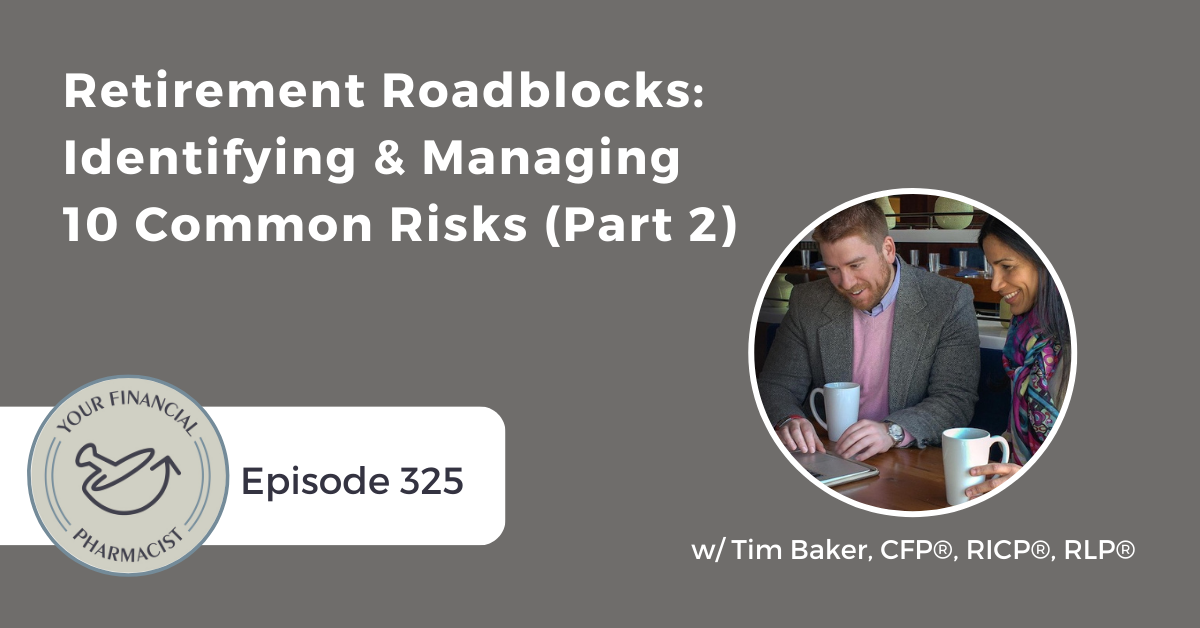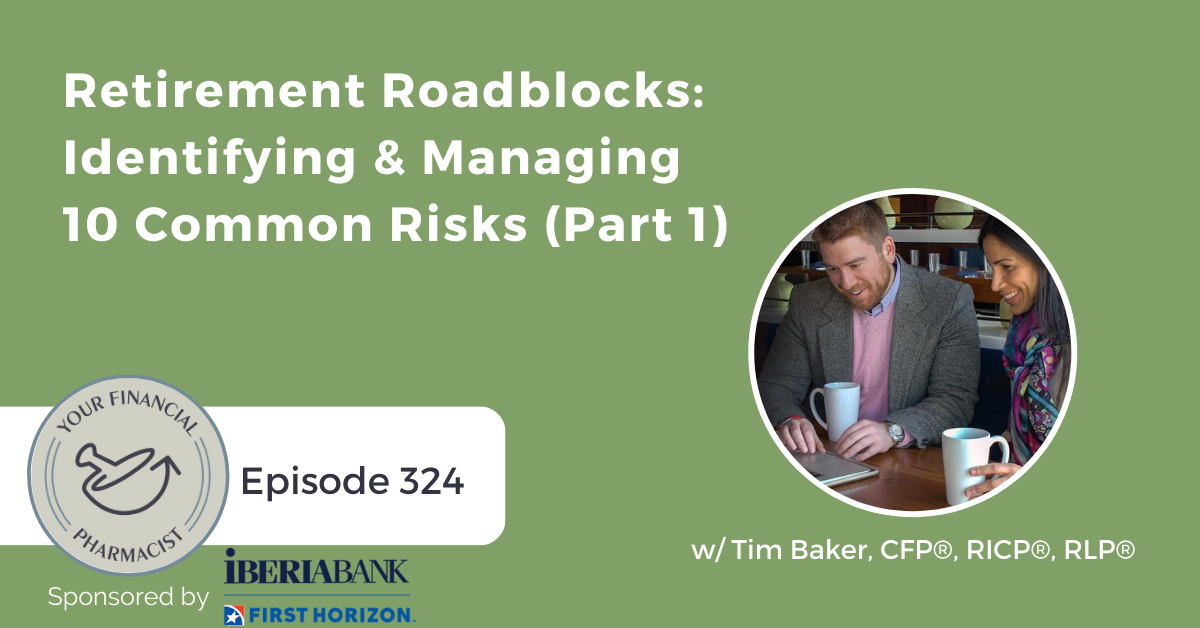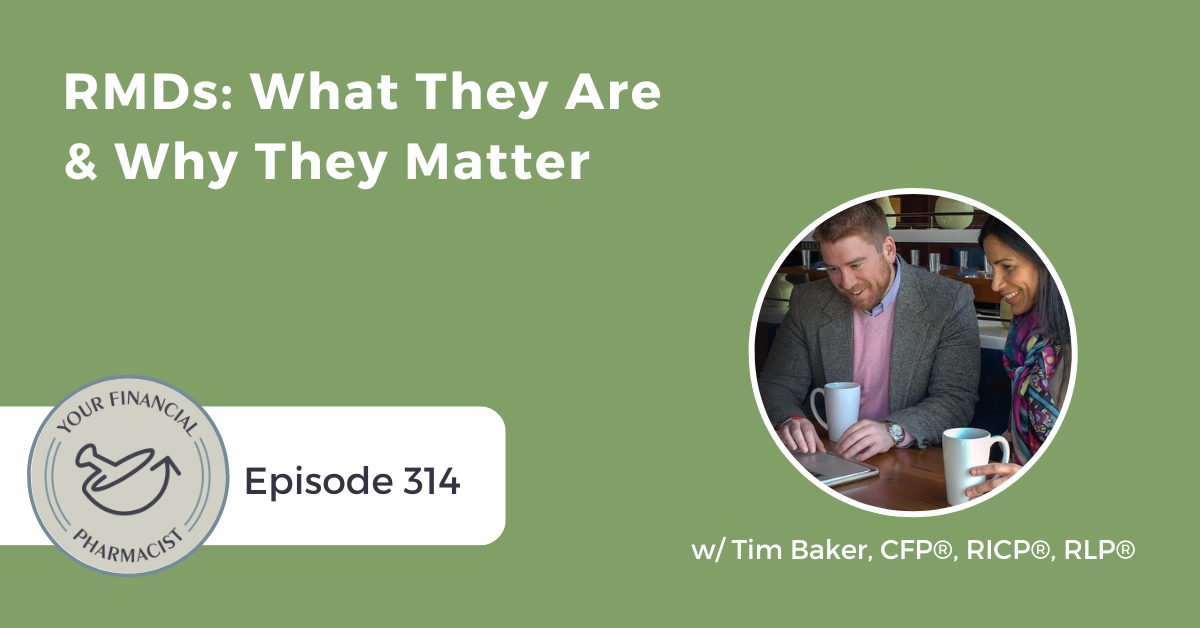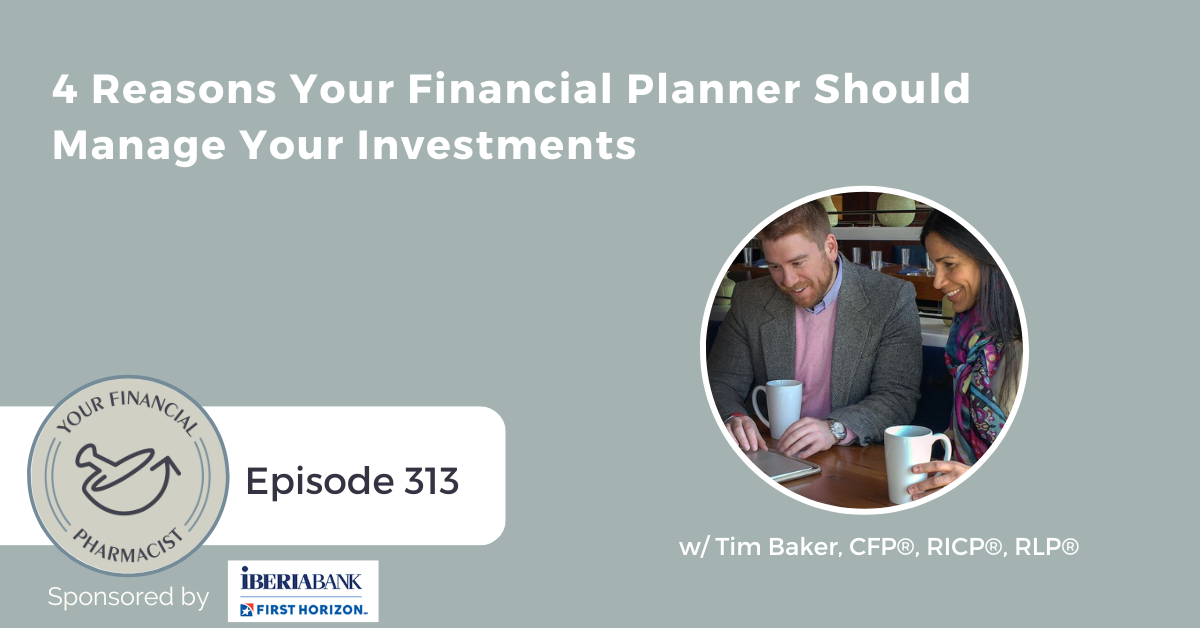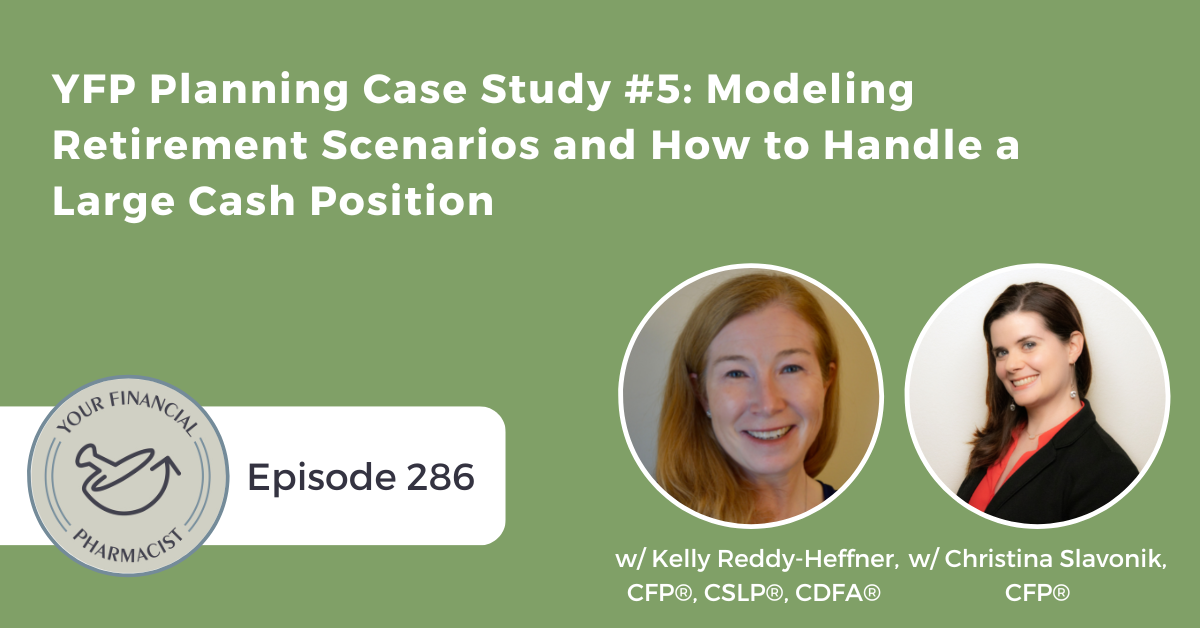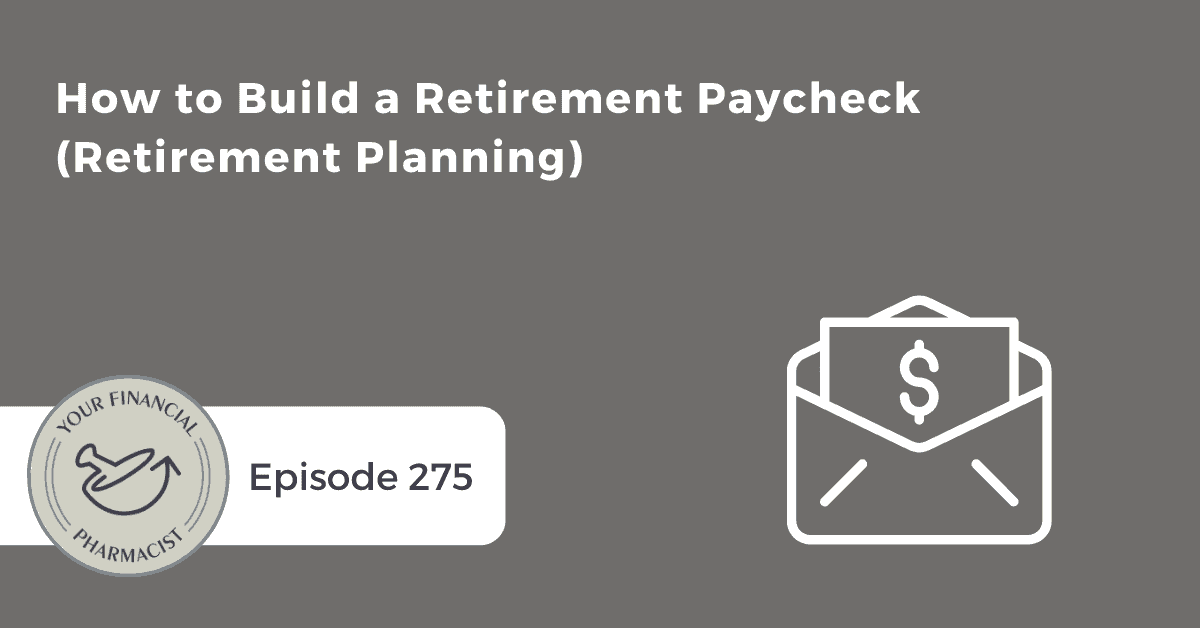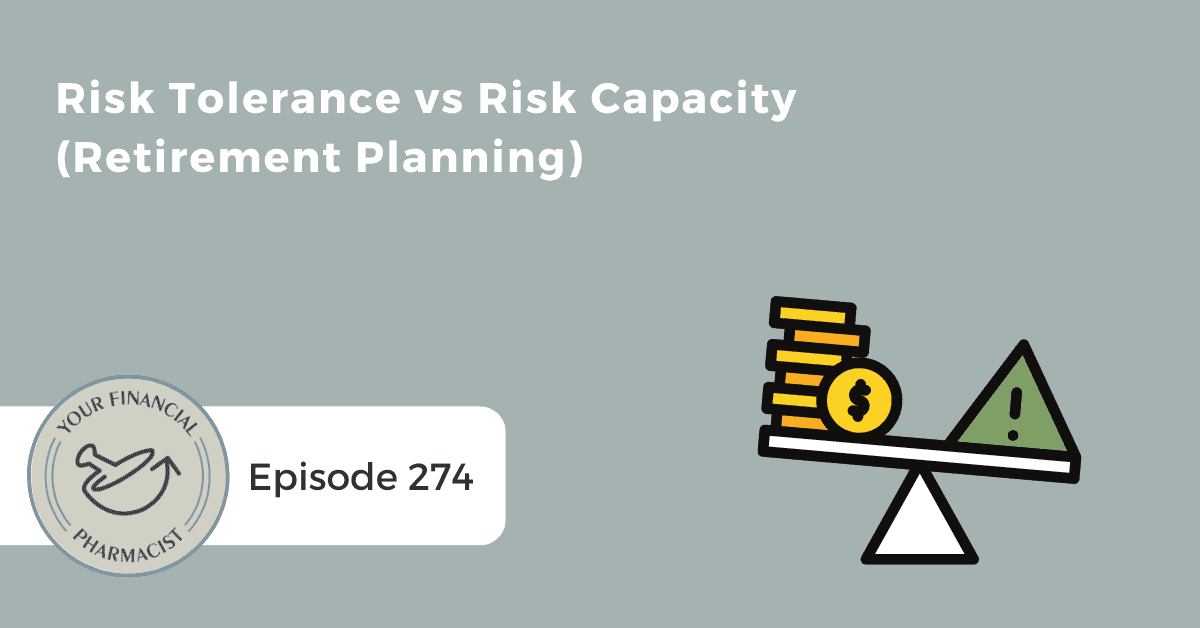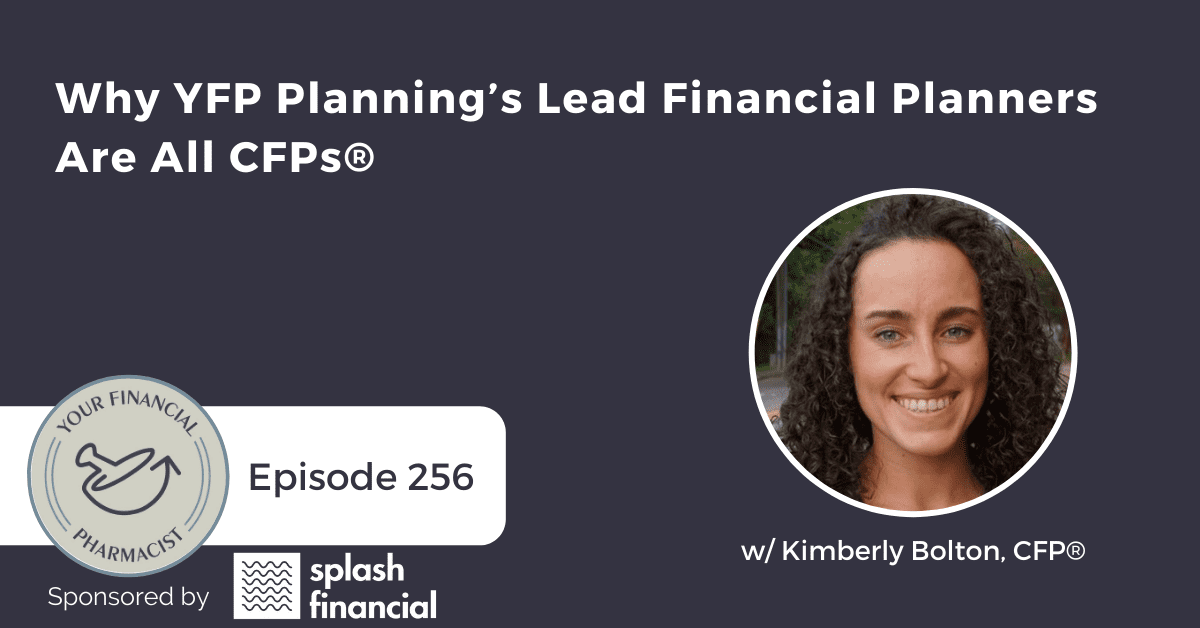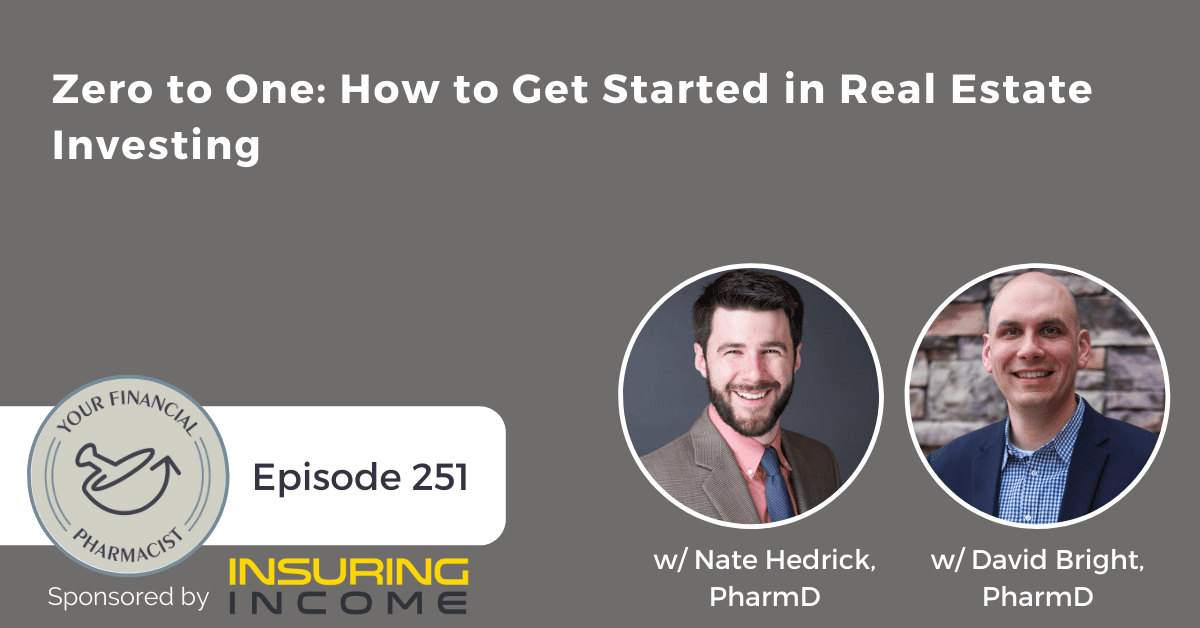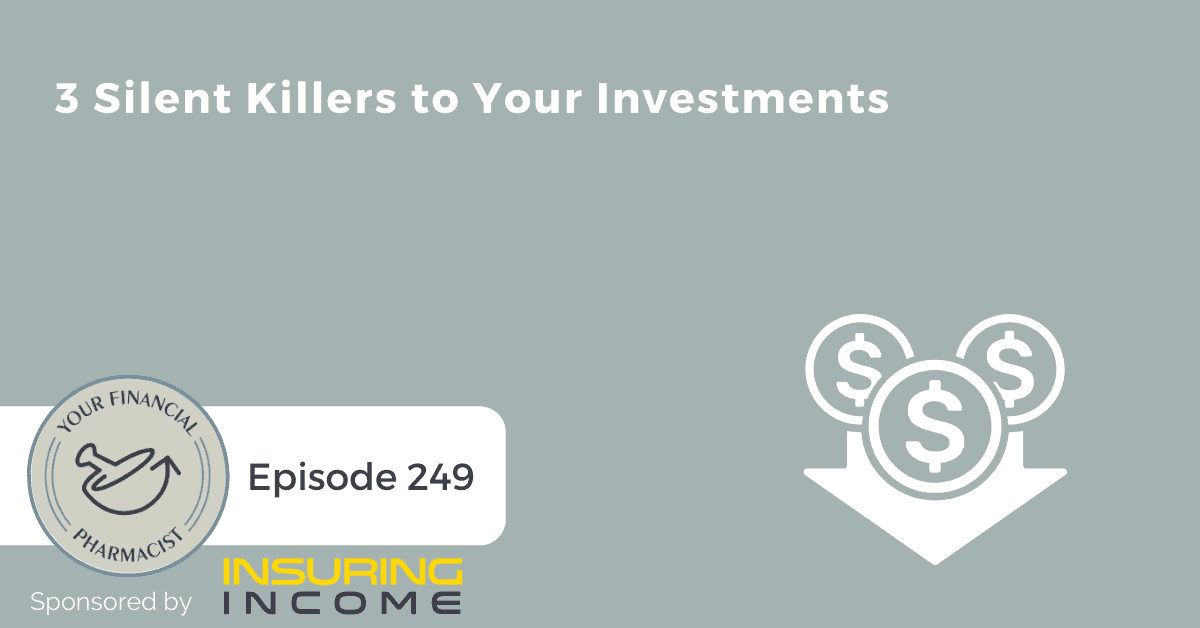YFP Co-Founder and CEO, Tim Ulbrich, PharmD and YFP Co-Founder and Director of Planning, Tim Baker, CFP®, RLP®, RICP®, wrap up a two-part series on 10 common retirement risks you should plan for.
Episode Summary
While a lot of emphasis is placed on the accumulation phase when preparing for retirement, there is considerably less focus on simple strategies for turning assets into retirement paychecks, for example. This week, Tim Ulbrich and Tim Baker wrap up a two-part series on 10 of the most common retirement risks you should be planning for. Today, Tim and Tim cover the five remaining risks: frailty risk, financial elder abuse risk, investment risk, work risk, and family risk.
Key Points From the Episode
- A brief recap of part one.
- Frailty risk and what its major financial effects are.
- How a good support system and a clear living situation can be a solution to frailty risk.
- Financial elder abuse risk, why it often goes unnoticed, and how to mitigate it.
- Why unity among siblings is important to avoid financial abuse of elders.
- Insight into investment risk and its subsections.
- How ensuring that your paycheck isn’t tied to the market can solve market risk.
- The value of flexibility and inflationary protection to protect yourself from investment risk.
- How liquidity risk plays a role in investment risk.
- Sequence of return risk and how it can damage your overall retirement sustainability.
- Work risk and some of the reasons that you might have to retire early.
- How planning for retirement readiness at different ages can assist with work risk.
- What re-employment means and how it affects work risk.
- How the loss of a spouse affects the person left behind financially and how to mitigate this.
- Ways that having unexpected financial responsibility can affect your retirement plan.
- Why having a third party you can trust to help with unexpected risks is helpful.
Episode Highlights
“Studies have shown that, the longer you retire, the more your mental health decreases over time.” — @TimBakerCFP [0:03:25]
“Involve trusted family members [to avoid elder financial abuse].” — @TimBakerCFP [0:10:16]
“You mitigate market risk when a lot of your paycheck is – not tied to the market.” — @TimBakerCFP [0:14:12]
Links Mentioned in Today’s Episode
- Free Download: Retirement Roadblocks: Identifying and Managing 10 Common Risks Guide
- YFP Planning: Fee-Only Financial Planning for Pharmacists
- YFP Disclaimer
- Tim Baker on LinkedIn
- Tim Ulbrich on LinkedIn
Episode Transcript
[INTRODUCTION]
[0:00:00.8] TU: Hey everybody, Tim Ulbrick here, and thank you for listening to The YFP Podcast where, each week, we strive to inspire and encourage you on your path towards achieving financial freedom.
This week, Tim Baker and I wrap up our two-part series on Ten Common Retirement Risks to Plan For. Now, in planning for retirement, so much attention is given to the accumulation phase but what doesn’t give a lot of press is how to turn those assets into a retirement paycheck for an unknown period of time. When building a plan to deploy your assets during retirement, it’s important to consider various risks to either mitigate or avoid altogether and that’s what we’re discussing during this two-part series, where today we cover the five remaining retirement risks, including frailty risk, financial elder, abuse risk, investment risk, work risk, and family risk.
Make sure to download our free guide that accompanies this two-part series, Retirement Roadblocks: Identifying and Managing 10 Common Risks. You can download that at, yourfinancialpharmacist.com/retirementrisks. Again, that’s yourfinancialpharmacist.com/retirementrisks.
Before we jump into my conversation with Tim Baker, let’s hear a brief message from YFP team member, Justin Woods.
[YFP MESSAGE]
[0:01:11.5] JW: This is Justin Woods from the YFP Team with a quick message before the show. If you listen to the YFP Podcast, you may learn something every now and then, either from Tim Ulbrick, Tim Baker or one of our guests. A lot of people listen to this show but they may not execute or implement the things they learn. As pharmacists, we know the impact of non-adherence on patient outcomes and their overall well-being.
As a pharmacist myself and part of the YFP Team, I talk with pharmacists every day who are confused about how to implement financial knowledge. Pharmacists share with me that they are treading water financially, maybe took a DIY approach, reached a plateau, and are confused about what to do next, or those who work for decades can see the light at the end of the tunnel and feel uncertain about how the next chapter will unfold.
If that sounds like you, one, it is not uncommon to feel that way, and two, does it make sense for us to have a conversation to see if YFP Planning can help you? Visit yfpplanning.com or follow the link in the show notes to find a time that works for your schedule.
[INTERVIEW]
[0:02:16.9] TU: Tim Baker, welcome back.
[0:02:18.7] TB: Good to be back Tim, how’s it going?
[0:02:20.1] TU: It is going well. Last week, we started this two-part series on 10 common retirement risks to be planning for. We talked about things like longevity risk, we talked about inflation risk, we talked about excess withdrawal risk. Listeners can tune back to that episode. We’ll link to that in the show notes if they didn’t already listen, and we’re going to continue on.
So number six on our list of 10 common retirement risks to plan for, number six is frailty risk. Tell us more about this.
[0:02:49.0] TB: Yeah, so this is more related to – it’s a risk that as a result of either mental or physical deterioration of your health, mental health, physical health that you as a retiree might not be able to have sound judgment in managing your financial affairs or care for your home, those are the two big ones.
So just like we talked about in the last episode, like, with long-term care and a long-term care risk, this is one that people are like, “Oh yeah, this is important but it’s not going to happen to me” and you know, what studies have shown is that you know, the longer that you retire, the more your mental health decreases over time.
So this is going to be, you know, where we really want a good support system. So a solution here is if we work longer, obviously, our mental acuity, our mental sharpness kind of stays intact longer. We’re not as isolated, there’s lots of studies about depression and loneliness, Tim, you know, creep in.
A lot of things that have not really been talked about as regarding retirement in the past and I think a lot of this points back to some of the frailty risk. So having a good network involving your family to have help, whether it’s with decision-making or chores, hiring someone to manage money or a trustee is another good solution here.
Set up a power of attorney for you know, the financial situation. It can even be you know, things like healthcare. Probably a big thing that I often hear is having a good discussion and analysis of like the living situation, right?
[0:04:40.9] TU: Yes, yes.
[0:04:41.1] TB: So a lot of people as they age, they might not necessarily want to move out of the house where they raise their family. A house that might be three, four, or five bedrooms that has a big yard, lots of yard work, lots of housework. Maybe stairs to go up and down and because of the – you know, kind of the emotional attachment to the house, it’s just hard for the retiree to move on and you know, potentially downsize or you know, move into a townhome or a condo or a community that is different.
That’s probably has one of the biggest effects on the frailty risk. You know, if you’re less likely, I think, to kind of be exposed to this risk if you have, again, more people around you that are dealing with the same thing. We mentioned a trust, so potentially putting assets in the living trust that are basically managed by the trustee which could be used as a retiree and then you could have a successor-trustee, which can be a family member or family members.
But the whole thing I think is to kind of you know, plan for this. You know, we want to make sure that we don’t necessarily have to go through the courts that we can kind of do this preemptive, even simplifying the finances. So things like you know, direct deposit, you know, automatic withdraw for bills, you know annuities, checks coming in the door rather than you know, having to make decisions regarding, “Okay, how much should I withdraw this year?”
These are all things that I think would help, you know, simplify and make this risk, not avoidable but mitigated, Tim.
[0:06:14.2] TU: Yeah, and as we wrap up the previous episode, part one, talking about the importance of planning for this early, right? So here, we’re talking about potentially deteriorating mental or physical health. You know, obviously, if and when that happens, guess it’s just a matter of time, right? For all of us but if and when that happens, we don’t want to be making these decisions in that moment, right?
So, how can we be having these conversations in advance? You talked about an important one that often comes up around housing, what’s the desire? You know, I’m thinking about things like legacy folders and making sure you’ve got good systems and documentations in place. I think the housing one comes up so often, you know? I’m thinking about even my own family. Like, sometimes it’s just hard to cut through the noise on this because you know, you gave one example where people may want to stay in their own home, I think that’s a common one.
The other one that I see as well is where people are adamant on like, “Hey, I don’t want to be a burden on the family. So, just put me in a facility.” It’s hard sometimes to cut through the noise of like, where does the true desire and how is that being projected and you know, maybe there’s an interest and a willingness and the financial means for children, you know, to be able to care for their elderly parents and that’s a desire, you know?
For them to do but you know, you can’t get through some of those conversations. So just again, I think in a point of advocacy for talking through as much of this as possible, as early as possible, and for those that are listening where you know, maybe they have adult children that are going to be important caregivers, you know initiating that conversation with your adult children and those that are the children that have aging parents, you know, initiating those conversations as well.
[0:07:49.6] TB: Absolutely.
[0:07:50.8] TU: Tim, number seven, one that’s not fun to talk about, one that we have to just given, you know, the reality of what it may be, which is financial elder abuse risk.
[0:08:00.5] TB: Yeah, and this is the risk of being – basically being taken advantage of because of frailty. So these are kind of linked, Tim, and I saw a stat out there that this can cost anywhere from like, three to 36 billion dollars a year or something like that. It’s insane and probably the biggest culprits of this is people that the retiree knows and knows well. So that could be an advisor, financial advisor.
It could be a family member, so adult children are probably the bigger abusers of this but 55% of these cases are family members, friends, neighbors, or caregivers, and the crime or the abuse can be anywhere from bad advice to fraud, barred against the person’s home. Theft, which could either be, you know, cash, taking money out of accounts, using credit cards, embezzlement.
You know, misuse of power of attorneys, and unfortunately and I think it’s why it’s so hard to kind of like put a number to this, in terms of like what the losses are is that the abuse often goes unnoticed because you know that retiree can be embarrassed. They really don’t want to punish those that are close to them or they have fear of losing care that is being provided even though they’re being abused or even reprisals.
And it’s one of the things that you know, as an advisor, even though we’re on that list of abusers, that we’re kind of trained to look for and ask questions in terms of like, “Okay, is there something going on? You know, what is the cognitive ability of this person? Are they making sound judgment? You know, who in the family is involved?” That type of thing.
And there’s been you know, I’ve heard of cases where it’s like, Mr. Jones is having USD 50,000 of work you know, done to his kitchen at 85 years old and that doesn’t necessarily make a lot of sense but it could be a contractor that’s kind of taking advantage and sometimes, Mr. Jones, it’s a little bit of – it’s being taken advantage of but it’s also could be like they like the company, you know?
So I think you know, a major solution for this, I would say is you know, involve trusted family members and I underline trusted and I underline the asset members. It’s a little bit of checks and balances. You know, if you have you know, two siblings that are kind of looking after, hopefully, they’re not both, you know, criminally minded but I think it’s good to have a few people that are you know, over-watching so to speak, the situation.
I think as much as the person, the retiree can protect themselves by staying organized, tracking possession, tracking their assets, you know, as much as they can open their own mail, sign their own checks, manage their investment, manage their statements, their investment accounts, their bank accounts, you know set up direct deposit as much as they can for social security checks or annuity payments.
That can again, help, not necessarily avoid but mitigate some of the exposure to this risk. You know, screen calls, solicitations, you know, get second opinions on, you know, we come across things even with clients where like, “Is this legit?” You know, like clients that are in their 30s, 40s, 50s and sometimes are like, “Uh, it’s not.”
So you know, get a second opinion and make sure that we’re kind of hyper-aware because this is a big problem unfortunately and it’s tough to kind of diagnose and see and you know, at every angle, you know, because often the person that’s being abused is like for what I mention, is not necessarily willing to kind of come forward with this.
[0:11:54.5] TU: Tim, I have to bring it up since you mentioned siblings. I think this is an area where there’s so many dynamics, right? Every family’s different but you know I think that when you’re dealing with assets and estates and you know obviously, one, at the end of the day, is going to get assigned as a power of attorney and you know, people that are in are not in the will and whether those conversations are transparent or not.
I feel like, any sibling dynamics, you know, you can just put a magnifying glass on them here. So you know, Cameron Huddleston, who we were referenced in a previous episode and we had her on a few episodes ago about initiating some of these financial conversations with your parents, talks about the importance of sibling conversations in unity, ideally, easier said than done, to then be able to obviously translate that with parents as well.
[0:12:40.4] TB: Yup, absolutely.
[0:12:41.9] TU: Tim, number eight, investment risk, we talked about this briefly in the first part of this two-part series but I think it warrants going a little bit deeper.
[0:12:50.8] TB: Yeah, so, investment risk, I’m kind of going to break this down into kind of sub-risk to this. So what I really want to kind of address here is market risk, interest rate risk related to the investments, liquidity risk, and then kind of come back to the sequence of return risk. So if I take these in turn, market risk is really the risk of financial loss resulting from movements in market prices.
So, unfortunately, Tim, the market just doesn’t kind of increase steadily. As we go, we have lots of you know, ups and downs and twists and turns with regard to the market which often makes us kind of queasy as – and I would say, even more. I feel like for me when I first started to invest back in my 20s, you know, I would kind of feel those investments and I’ve kind of got to a point where I get zen and I try to like not pay attention to it because again, it’s not going to affect me until hopefully 30 years in the future when I do retire.
[0:13:46.6] TU: You should do some market meditations, right? Like –
[0:13:48.6] TB: Yeah, exactly but for a retiree, who you know, like their paycheck and their livelihood is kind of tied to the market, I could see how that could be overwhelming and distracting. So a solution here is I think, I really strive for balance and flexibility. So, we kind of mentioned in the past, like a flooring strategy.
So you mitigate market risk when a lot of your paycheck is not coming or not tied to the market. So that’s where we you know, are essentially, we’re looking at essential expenses and we’re saying, “Hey, my essential expenses or my basic needs are covered with an annuity” or social security or very low risk, you know, government securities like treasury bonds. You know, treasury bonds, notes, that type of thing and we’re good.
The other part of that is allocation. So obviously, a lower percent of your portfolio in equity, you know, particularly leading up to retirement is going to be important to kind of mitigate market risk. So even in some of the – you know, the dot com crisis, the subprime mortgage crisis, you know, the COVID crisis, like the market is still doing this but if you have less equity exposure, it might not be Rocky Mountains ups and downs.
It might be Appalachian Mountains ups and downs, where it’s a little bit smoother but I think, knowing what your allocation and what your glide path is, actually approach retirement is going to be important and then you know finally, I think for this particular risk is kind of going back to flexibility.
So if you’re in a year where the market is down and maybe inflation is up, you know, inflation is up, like maybe we say, “Okay, we’re not going to take that USD 15,000 out to go travel.” you know, do this huge cruise or make this, “We’re going to forego that and see when the market kind of recovers and then we’ll kind of assess it from there.” So flexibility of like, what you’re withdrawing and when I think is going to be important with regard to market risk.
The other ones, Tim, interest rate risk. So this is related to investment risk. So this is the risk of the change in value of an asset as a result of volatility in interest rates. So what does this mean? This essentially means that when interest rates go up as they have been over the last couple of years, the price of bonds go down. So there’s an inverse relationship. So, the price of individual bonds and bond mutual funds decreases.
So when interest rates go down, the price of bonds go up. So this is not necessarily a concern when bonds are held to maturity or what I was mentioning in the last episode, a bond ladder. So if I buy a year, a bond, or six-month bond that basically, you know, comes up at the end of the next or at the end of this year or a year, 18 months, or whatever that looks like, if it holds maturity, the fluctuation in interest rates do not affect the bond price.
So you’re kind of inoculated from that. It’s when you kind of are coming in and out of bonds, that’s where it becomes problematic. The other risk associated with this is and I’ve seen this, so one of the things that I – because I’m a nerd, but one of the things I do with my emergency fund is I buy 12 months CDs every quarter. So I have a quarter one CD. So let’s pretend I have USD 20,000 in my emergency fund.
10,000 might be in the high-yield savings account, 10,000 might be split up between four CDs and you can kind of think of these as like bonds. So Q1, I have 2,500, January one. Q2, April one, so on and so forth. So as prices, as interest rates have gone up, if I look back 12 months ago, man, I look at that interest rate, I’m like, “Man, that’s really low”. So when I renew, Tim, the – what I’m getting in terms of interest is a lot higher.
The opposite came true, and this is what’s called reinvestment risk. I could have this bond that I just bought at five or you know, the CD or bond that I just bought at 5% but in a year or two years, it could be at 3% and then that’s the reinvestment risk. So that’s another risk that we have to, you know, kind of be aware of. So I think the biggest they hear is, again, things that are inflation-protected.
So any type of income stream or investment that has inflationary protection like tips or strips, any type of COLA protection that’s going to really – what’s going to be to help reduce that risk and then finally with – or not finally, the third one is liquidity risk. So this is just basically the inability to have assets available to financially support unanticipated cashflow needs. I don’t think that this is a risk that’s really inherent just to retirement, we all have this at all times.
It might be a little bit harder to overcome because we don’t have – we don’t necessarily have cash flow from like a set job but planning for this, you know kind of plan as best you can for what could happen. So what are the situations and then what levers can we pull? What are the assets that can be sold? You know, what are things that can’t be sold, which you know, assets that can be sold.
It could be things like stocks and bonds and things like that. Maybe not so easily, it could be a business interest or real estate. You know, what are some other things that we can talk about to pull? Whether that’s life insurance, a HELOC, a reverse mortgage, and then one of the best reasons to employ a systemic withdrawal strategy is because of the flexibility.
Because you have this pot of money that you can reach into and say, “Okay, I didn’t think needed USD 30,000 for X but now, because that money is there and I can put it into liquid form and pour it” then you know, that’s one of the things, versus, if you were to say, “Hey, I’m going to put all my money to an annuity” that’s not flexible and that’s not liquid.
So it allows you to change your strategy in the face of you know, new information, new situations, and finally, the last one here and again, Tim, we could probably do a whole episode on sequence of return risk is this is the risk that the timing of your withdrawals from a retirement account will damage your overall return and really like sustainability.
So when you withdraw from a bare market or when the market is down, it’s more costly than if you draw – you make that same exact withdrawal in a bull market. So this is – so what we’re saying is that a large negative return during retirement, so during that risk zone, that eye of the storm of you know, 10 years before retirement, 10 years after retirement, has a much bigger impact on wealth accumulation and success in retirement than a negative return outside of that.
You know, so that’s why I’m saying that at 40, you know, I get zen because I’m like, “It doesn’t really affect me if the market goes down 40% because I know I have 30 years for it to recover” and it’s going to go down 40% a couple of times probably over the next 30 years but if I’m retiring in five years, I’m worried, Tim.
And again, like that’s where we have to be as safe as we can, you know, throughout our wealth accumulation journey is right in that zone, you know, five to 10 years before and five to 10 years after and this is when your retirement accounts are most vulnerable to investment returns and if you think about it, it kind of makes sense because this is typically, Tim, where you have the highest balance.
[0:21:29.9] TU: That’s right.
[0:21:31.2] TB: So wealth rises rapidly as you approach your retirement date due to the fact that you’re putting in probably the most in contributions you ever have because you know, a lot of people are like, “Oh, I didn’t do enough of this, I need to make up, I got to catch up” because of investment returns and compounding.
So that’s when you’re – you know, and the research says that in a defined contribution plan, say, like a 401(k), this is interesting, you accumulate half the value of the account in the final 10 years of savings. So we say save early and often but what moves the needle most is in the last 10 years. In the early years of savings, additional contributions can replenish account losses but later, the contributions are a much, much smaller needle mover than it is like investment losses or gains.
[0:22:21.2] TU: Yeah, and Tim, just to put – you know, I was thinking about this because I think it’s harder, especially if folks are earlier in their career to understand kind of the numbers of this. If you’re nearing retirement, you have a three-million-dollar portfolio, as you mentioned, one part that’s going to keep driving that up is typically your, maybe you feel like you had to play catch up or you’ve got more discretionary income at that phase.
You’re hyper-saving, trying to max that account but even if we just look at that three-million-dollar portfolio and assume something like a 5% return in that year, you know, USD 150,000 of growth that’s going to happen in that portfolio in that year, right? And you know, people that are early saving, the timeline to get to 150 can feel like forever, and here, we’re talking about 150 of growth in a portfolio just in that single year. So I think that makes sense.
[0:23:05.4] TB: Yeah, and if you compare that to what you can legally contribute, that’s the big thing.
[0:23:11.8] TU: Oh my gosh.
[0:23:12.7] TB: Whereas like, you know now, you’re like, “Oh, 20,500, that’s like, that might be a third of my savings.” So it’s huge. So really, what the research shows that the magnitude of the impact of a large negative investment return or shock grew as the shock occurred closer to retirement.
[0:23:34.8] TU: Yeah, exactly.
[0:23:35.7] TB: So it’s like if the epicenter is – if the epicenter of that shock is close to age 65 when you retire, the consequences are greater than if it were at 58, which makes sense. So for sequence risk, the order of returns becomes a far more important concern in that span of time over the breadth of the entire portfolio, particularly in accumulation, it’s the average return that matters, right?
So one of the things that I often say is like, “Hey, you don’t need a lot of bonds in your 20s, 30s, 40s” and I would even say even your 50s unless you’re retiring in your 50s, you don’t need a ton of bonds. So you want to almost have like a cliff, where you’re very much like pedal to the metal, you know you’re primarily in equities and then when you get to that 10-year, that’s where you start shifting, downshifting considerably.
So like a hard break versus what a lot of people do is they kind of glide into it. So in their 40s, they put a little bit more bonds, in their 50s they put a little bit more bonds and so on and I just think that and I understand why, you know, you’re kind of easing into it but I just think you leave a lot of meat on the bone with regard to investment returns but the same is true is like you kind of have to like you know, you kind of have to get into that period of 10 to 15 or 10 years pre-imposed retirement date and then start adding equities back in, which a lot of people don’t do.
So the solution for this is asset allocation and whether you follow on collide path or not in terms of you know, percentage of equities to bonds. Knowing what that is, we often see in the accumulation phase I think not the proper asset allocation, so too heavily in bonds and then closer to retirement, actually too heavily in equities. So if you have one of those shocks where the market is down, that’s where we have to have real conversations of like, “Hey, maybe we need to push out retirement to the market.”
[0:25:34.3] TU: Retirement date, yeah.
[0:25:35.6] TB: The market corrects. Again, flexibility; allow for changes and what is what’s wrong. So if it’s a down market, you know either decrease the amount that we’re withdrawing or actually that the entire – shift the entire equation where you know, we’re not retiring this year or next year, we’re retiring when the market recovers and then another solution is to kind of get out of the game or at least partially convert a portion of the portfolio to an income annuity, which essentially you know, means less overall volatility because you have that income for in place.
[0:26:10.7] TU: Yeah, Tim, great overview. The investment risk to your point, we probably can and should cover this in more detail in future episodes and I think flexibility keeps coming back as a theme but I want to acknowledge how hard that can be, right? When you talk about something like, “Hey, maybe shifting your retirement date” makes a whole lot of sense objectively, right?
If I had planned a retirement age, I’m listening of you know, 2026 and we see the market tank in 2025 like I’ve been mentally preparing for retirement in 2026, that’s a hard thing to consider but I think that open-mindedness and the options to be able to pursue some of those things that gives you more of that flexibility to maximize your portfolio is going to be really important. The other thing I just want to mention that we see a lot because especially folks that are maybe introductory in terms of investing or learning or aren’t working with a planner.
I’m thinking about a lot of folks that are investing heavily in target date funds, where we maybe see some of that conservative investing happening too early, in my opinion, in the portfolio, yeah.
[0:27:12.5] TB: Yeah and just to go back to what you’re – yeah, I completely agree it is and again, not every target date fund is created equal. We actually crack those target date funds open and you can see the allocation, you know something then might be 2035. You know, if you stack up a 2035 or 2055, you know target date fund, what is in target date fund A is going to be, you know 2035 is going to be a lot different than what’s in a target date fund B that’s in 2035.
But to go back to your other point, you know like and we’re going to get into this in the next couple of risks here, sometimes like you’ve mentally said, “All right, I’m going to work for another two years” sometimes that decision is made for you and that could be hard. So then what do you do?
So I think a lot of these risk is like if you can kind of maintain as much control over your destiny and I think part of this is having options, particularly with things related to work, it allows you to kind of pivot and adjust and kind of parry some of these things that are thrown at you because I keep saying, “I want to retire at age 70” you know? I mentioned earlier in the first episode of this is like that might be out of my control and you know, that’s something else we have to account for.
[0:28:36.5] TU: Yeah, if Mike Tyson were listening, he’d say, “Everyone has a plan until they get punched in the mouth” so yeah.
[0:28:41.0] TB: Yeah, exactly.
[0:28:42.4] TU: So let’s talk about that, work risk is number nine on our list. What is that?
[0:28:46.5] TB: So again, I’m going to break this down into some sub-risk. So the first one would be forced retirement risk. So this is the risk that work well and prematurely because of poor health, disability, job loss or to care for a family member because of some of these issues and this is an eye-opening stat, Tim, is 40% of retirees retire earlier than they plan and it’s really because of one of those issues, health, job loss, caring for a family member.
This happened to my dad. My dad tells the story, you know, when we try to talk about this, you know his company was bought by another company. He was kind of duplicitous, you know, kind of at the tail end of his career and he was laid off. So it was – so if he was planning to retire by X and his portfolio and all, we had to kind of reconfigure, jostle things around, and make sure that we’re planning accordingly.
So I think having like a pulse on kind of your retirement readiness at different ages, “So okay, what happens to my plan if I have to retire 10 years before I want to?” So for me, it will be 60, right? 65 like what happens.
[0:29:54.8] TU: Yes, zero, one, two, three.
[0:29:56.3] TB: Yeah and you know, what happens to my lifestyle, you know, what do I have to – like are there things that I, other levers that I can pull? So one of those I think is career. So I think staying current, you know learning new skills. You know I think, Tim, like we’re naturally like this as like lifetime learners and always trying to you know, self-improve. That’s not everyone’s cup of tea but I think maintaining your network.
I don’t know the last time I actually put my resume together, Tim but I think that would be something that you would want to do. It is a lot easier to kind of brush that up every year or so versus kind of cracking that open every decade. Are there – is there opportunities to pivot to consulting, to kind of work on your own? I think a lot of people paying attention to severance policies and negotiating benefits related to your career is going to be important.
Another thing to kind of you know, mitigate the health stuff is maintaining a healthy lifestyle. So you know diet, weight, sleep, exercise, and potentially reducing stress by cutting back hours. So we kind of mentioned of like a glide path of going from a one to a point eight to a point six, you know to work in a couple of hours here and there. So I think that can potentially allow you to work part-time longer into retirement by maintaining a healthy lifestyle, maybe meditation, all that kind of stuff.
The second work risk we talk about is re-employment risk. So this is the inability to supplement retirement income with employment due to kind of down job markets, poor health, or if you’re caring for others. So I think for my dad, you know when I happened to him you know I think it was hard for him because he had worked for the same company for 40 plus years to actually go into market and interview and do something else.
So for him, it was kind of more about like comfortability and he really didn’t have anything else outside of that where he could consult or do part-time. Like I’ve heard people like drive a bus for a school and liking that because you know, they’re connected to kids or turning hobbies into profit-making activities. I was talking with my brother and his fiancé last night because we were actually talking about, “Hey, when do you want to retire, and when is that?”
You know, one of the things that he brought up that I thought was interesting, he’s like, “I think I’d love to do like a bed and breakfast.” That’s cool. You know, he likes to cook, he likes to host, so I think that would be something that would be good for him.
[0:32:37.3] TU: That is cool, yeah.
[0:32:39.4] TB: Planning on earning significant income in retirement may be unrealistic for a lot of people. There are certain industries where it’s very easily, you can very easily kind of pivot to a consultant role and make just as much money as you would working full-time but that’s not necessarily the case for a lot of people.
So I think kind of again, planning for this, talking through this, and understanding you know, what are some things that you can potentially lean on or pivot to in the event that what you thought was a short thing, which was like your employment is not so much and again, I think this often is one of those things where it’s like, “Hey, that’s not going to happen to me.”
[0:33:25.4] TU: Yeah.
[0:33:25.8] TB: I think this has probably evolved over time, right Tim? Because again, it’s rare where you find someone like my dad that’s worked for the same company for 40 or 45 years. So I think our eyes are a little bit more open to this risk but I think what maybe might not be is the fact that like, “Hey, your health or someone close to you” or something like that could affect your timeline, so to speak for retirement.
[0:33:50.1] TU: Yeah, and as you’re talking Tim, I’m thinking about many people in our community of which many of them have been on the podcast where you know I think they may intentionally or unintentionally are preparing themselves for something like this and the risk you’re talking about, right? They’ve got you know, maybe they’re investing in real estate in a variety of ways, they’re working a full-time job.
They’re doing some consulting, they’ve got a side hustle, they maintain an active network, you know, they’re constantly developing their skills, right? Just multiple strategies of diversification that I think help mitigate against some of the risks that you’re talking and maybe they’re not even thinking about it in that way, it’s coming from an area of energy and passion but it can be really helpful as we talk about strategies to plan for this type of risk.
[0:34:33.3] TB: Yeah, absolutely.
[0:34:35.0] TU: All right, number 10 on our list is family risk. Take us home, Tim.
[0:34:41.4] TB: Yeah, so the two kind of sub-risk that we would talk here is kind of the loss of spouse risk and then unexpected family financial responsibility risk. So the loss of spouse essentially is where you know, I’ll use myself, I retire at 70. I think I’m going to live at least to 87 or 95 and I pass away unexpectedly at 72, right? So the problem often with that is you know, you’re often, for many spouses, you’re kind of known two social security income streams, right?
You know, so one of those goes away, you keep the highest one but the problem – so you still have all of the assets. The spouse will inherit all the assets that are in their name obviously but what typically doesn’t reduce is a lot of like living expenses, right? So your food might go down but you’re still going to have to pay if you have a mortgage.
[0:35:41.9] TU: Property taxes, yeah.
[0:35:42.8] TB: Or you know, rent or things like that, tax, all of those, your utilities are going to be very similar. So just because your income or a good chunk of your income could be cut in half or even a third, your expenses don’t and what we’ve seen at least with baby boomers is that you could be a widow or a widower for 15 or 20 years. So it’s not like you know one and this happened where one spouse dies and the one will die within a year or two.
I mean, but that does happen but you could have long periods of time where you’re by yourself. There was a stat that I saw that was really interesting Tim, was within five years of a death of a spouse, 40% of widows become impoverished.
[0:36:29.9] TU: Wow.
[0:36:31.1] TB: That’s insane to me and I think if I had to guess, I don’t know this Tim, but if I had to guess, I would think that that’s probably again, people that are lower income that might like a huge chunk of their livelihood is in disability. So if a good chunk or not, disability, social security, so a good chunk of that goes away, so you have two paychecks is now one, you know that could be very problematic for kind of sustainability of overall wealth.
But that to me was eye-opening and I’ve heard that before with husbands will say like, “I just want to make sure my wife is taken care of if I’m gone” and again, I don’t want to get into much of like gender roles and things like that.
[0:37:17.4] TU: Sure.
[0:37:17.8] TB: But I still think that that exists in a lot of relationships, particularly older couples where you know, one partner handles the money and the other one doesn’t or has an interest in the other one doesn’t. So you know I think the solution for this is and I’ve talked to people in the past is like, “I want a relationship with like an adviser where I trust them because even when I’m gone they’re going to take care of the person, you know, my spouse.”
So I think having a relationship with that, with like a planner I think can be important. I think involvement, you know I often say this with couples of all ages, you know the more that you are involved with your plan.
[0:38:00.6] TU: Absolutely, yes.
[0:38:02.0] TB: And the more you are engaged with the plan like both of you, I think the better the results will be but I also understand that there’s some like, there’s some couples that there might be engagement in the front end and then maybe one spouse kind of you know drives the train after that but then often what happens is like again, if that spouse dies like they kind of have to reengage is necessarily like the easiest thing.
So you know, what are the contingency plans if this were to happen? Even sometimes like when we – so if we were to say, “Hey Tim, you know we’re going to peel off a quarter million dollars of your portfolio to provide an income for you and Jess.” What’s attractive about those payoff schedules is like the one that just pays your lifetime is the highest but we would want to say, “Okay, let’s have a joint life payout.” So it would pay you as long as one of you are alive but that benefit is going to be lower.
[0:38:54.8] TU: Yeah.
[0:38:55.4] TB: So decisions like that, you know if you have second-to-die policies or you know again, social security claim, and there is a lot of people that they don’t look at the layers of that decision that says, “Okay, even if Tim is in poor health than Shay, if I have a larger benefit that I want to defer that I should defer, that benefit grows and then when I pass away, Shay takes that on.”
So some of that, some of those nuances aren’t necessarily you know, evaluated. So those would all be things that you know again, it’s not just the abrupt, “Okay, the husband is gone or the wife is gone,” these are things that we have to bake into the plan as we go because you know, things like social security or you know, payouts and things like that have to be decided. So it’s not just the abrupt, “Okay, what happens once that happens in that moment?”
It’s the multitude of decisions that you have to make potentially leading up to that and then lastly, it’s the unexpected financial responsibility risk. So this is kind of the risk of failure to launch, Tim. Like, “Hey, I’m 40 years old. I just lost my job” or “I’m divorced. I’m moving back in with mom and dad” or you know, care of a grandchild or because parents have problems with the law or drug addiction.
These things happen you know and sometimes, we can kind of put this thing in like a liquidity risk of like unanticipated events but I would say like those would be things that I would want as a planner to know like, “Is there a possibility for this and if this were to happen, what do we do?”
[0:40:40.8] TU: Yeah.
[0:40:41.3] TB: So that’s another you know, risk associated with family. Families can be great obviously but sometimes, you know that’s kind of my biggest fears. You know, I want to make sure that as I’m raising my kids and I know it’s the same, it’s true with you, Tim, like they can be contributing members of society that can you know, be self-sustaining but sometimes that’s even out of their hands, right? So we want to make sure that in the event that that happens, we can plan accordingly.
[0:41:11.4] TU: Tim, as you talk about loss of spouse, a couple of things are coming up for me. One that’s timely, you know where Jess and I are working on, just updating your legacy folder that we created several years back but in our planning with Kelly from our team. You know, it’s a part of the process that we need to go back to and update it and you know to you comment about the importance of joint planning and all parties being involved ideally.
Even in this situation where Jess and I feel like are both very well informed, I do take a little bit more of the lead but it is very much a shared agenda and execution and both of us engage with Kelly and the planning. You know, instructions on that legacy folder, while they’re spelled out as much as possible, you know for either one of us or in the event that both of us were to pass away, for our parents or whoever it be taking care of the finances and the boys, it’s, “Go call Kelly.”
Like someone we trust that knows this plan inside out, that has these documents, that understands all of the nuances and what is going on and that is so reassuring. Again, assumption is you have someone you trust. It’s so reassuring to know you’ve got a third party that not only is there to help you develop the plan but is there in the event of some of these challenging situations that may come up to make sure that we’re executing how we wanted it to be executed.
[0:42:29.1] TB: Yeah, and I think what’s not covered in that like I love the idea of like, “Okay, Kelly is a safe haven. She has the documents, she knows your situation” I think it’s hugely, hugely important but I think what’s also not necessarily discussed in this is kind of like the emotional or social like you know, my parents were in town this week, last week and this week. It’s been cool because my brother has been in town too. So the three of us have been spending – my dad just turned 77.
[0:43:04.9] TU: Baker pow-wow.
[0:43:05.7] TB: Yeah, and we’re joking with my dad that like if mom passed away like I don’t think my dad knows how to do like a load of laundry. I love you Dad but he’s very much dependent on my mom over you know, decades and decades of marriage. If something were to happen to them like I think he would have to move in with one of us to live and I’m sure a lot of people are thinking about their parents and they’re like, “That’s my dad” or “That’s my mom.”
You know, I think even that of the loss of spouse not just from a financial standpoint or like where are the documents or things like that, it’s kind of a day-to-day living in terms of like what am I doing or what can I do or what can I not do and who am I leaning on and you know, I think that kids are probably the first people that are in that role but I think like having those conversations before that happens where maybe there’s less emotion involved is smart.
So it’s not just the numbers, it’s what’s the quality of life? What are the things that we’re going to do to move forward? And unfortunately, it is part of life and I think the more that you can kind of get in front of things just like anything else, I think the better result you’ll have.
[0:44:28.6] TU: Yeah, the other thing to your point about the emotional journey that’s coming up is a throwback almost four years ago now but we had on episode 127, we had on Michelle Cooper, who wrote the book, I’ve Still Got Me: A Widow’s Journey to Love, Happiness & Financial Independence, lost her husband to suicide and talks about not only the importance of joint planning and shared understanding of processes and documentation but also navigating that in the midst of that emotional loss.
Great interview, great resource. We’ll link to that in the show notes as well. Tim, this has been fantastic as we’ve covered in two episodes now 10 of these risks we need to be planning for and mitigating the best that we can. For folks that are listening, you know you heard a theme here of early planning. Obviously, we would love to have the opportunity to talk with you if you are interested in working more with one-on-one with a financial planner that you can trust.
We’ve got a team of fee-only certified financial planners, tax professionals that work with pharmacists households all across the country at all stages of their career. You can learn more by going to yfpplanning.com and you can book a free discovery call from that site. Again, yfpplanning.com. Tim Baker, as always, great stuff. Thanks for the contribution.
[0:45:41.4] TB: Yeah, thanks, Tim.
[DISCLAIMER]
[0:45:42.4] TU: As we conclude this week’s podcast, an important reminder that the content on this show is provided to you for informational purposes only and it is not intended to provide and should not be relied on for investment or any other advice. Information on the podcast and corresponding materials should not be construed as a solicitation or offer to buy or sell any investment or related financial products. We urge listeners to consult with a financial advisor with respect to any investment.
Furthermore, the information contained in our archived newsletters, blog posts, and podcasts is not updated and may not be accurate at the time you listen to it on the podcast. Opinions and analyses expressed herein are solely those of Your Financial Pharmacist unless otherwise noted and constitute judgments as of the dates published. Such information may contain forward-looking statements, which are not intended to be guarantees of future events. Actual results could differ materially from those anticipated in the forward-looking statements. For more information, please visit yourfinancialpharmacist.com/disclaimer.
Thank you again for your support of the Your Financial Pharmacist Podcast. Have a great rest of your week.
[END]
Current Student Loan Refinance Offers
Note: Referral fees from affiliate links in this table are sent to the non-profit YFP Gives. | Bonus | Starting Rates | About | YFP Gives accepts advertising compensation from companies that appear on this site, which impacts the location and order in which brands (and/or their products) are presented, and also impacts the score that is assigned to it. Company lists on this page DO NOT imply endorsement. We do not feature all providers on the market. |
$800* Loans* ≥150K = $800 100-149K = $450 <100K = $350 | Variable: 5.28%+ APR (with autopay)* Fixed: 5.28%+ APR (with autopay)* *All bonus payments are by gift card. See terms | The "Kayak" of student loan refinancing, Credible displays personalized prequalified rates from multiple lenders | ||
$750* Loans ≥150K = $750* ≥50K-150k = $300 | Fixed: 5.49%+ APR (with autopay) | A marketplace that compares multiple lenders that are credit unions and local banks | ||
$500* Loans ≥50K = $500 | Variable: 4.99%+ (with autopay)* Fixed: 4.96%+ (with autopay)** Read rates and terms at SplashFinancial.com | Splash is a marketplace with loans available from an exclusive network of credit unions and banks as well as U-Fi, Laurenl Road, and PenFed |
Recent Posts
[pt_view id=”f651872qnv”]

